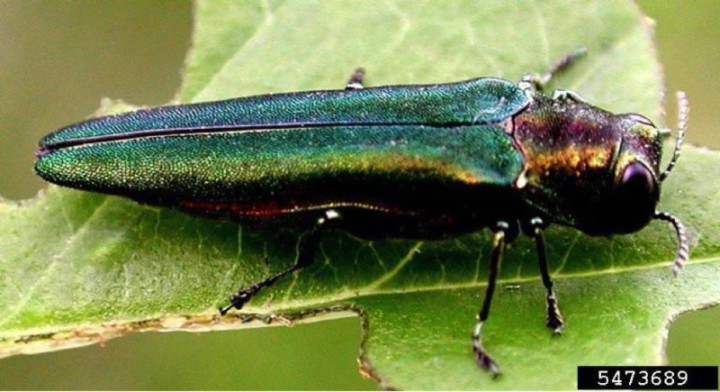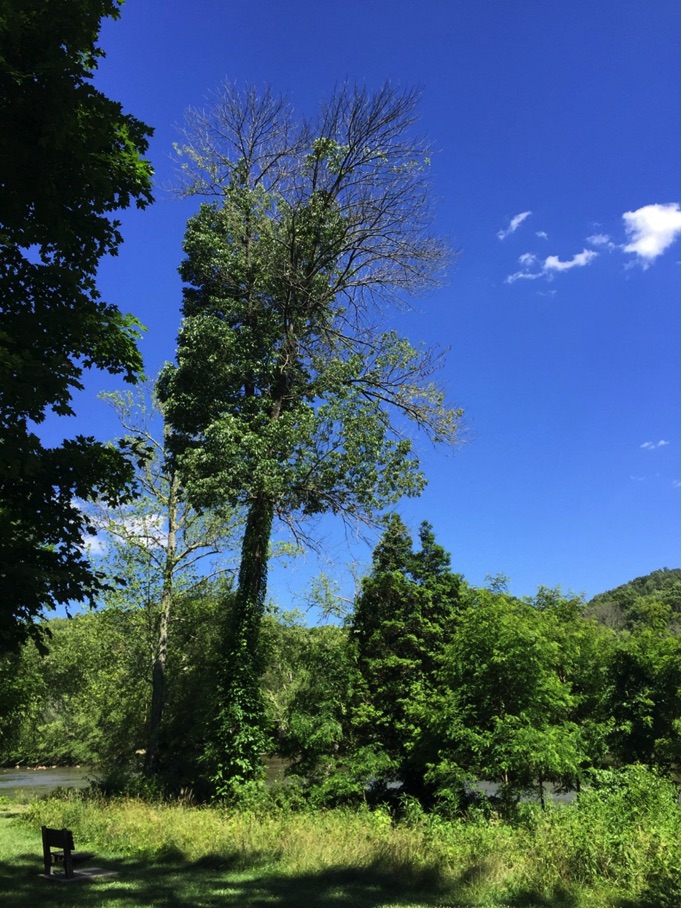There’s a new threat to forests in Western North Carolina and — like the hemlock woolly adelgid that’s killed hundreds of thousands of trees in the region — it originated in the forests of China. Also like the woolly adelgid, the new pest lacks natural enemies in our eastern woods.
According to the U.S. Forest Service, the emerald ash borer is killing ash trees in Pisgah National Forest and on private lands along the French Broad River between the Tennessee state line and Marshall.
The borer-affected trees die quickly, usually within a year or two of infestation. Weakened or dead trees can create unsafe conditions in areas where ash trees predominate, especially in windy conditions or in ice or snow storms, Forest Service spokeswoman Cathy Dowd reports.
The Forest Service will focus on removing dead trees from campgrounds and other public recreation areas, says Dowd, but dead and dying trees will remain along hiking trails and roadsides throughout the forest. She recommends that people watch for patches with many dead trees and avoid those areas.

The emerald ash borer lays its eggs in the bark of ash trees, and the larvae eat the inner bark, preventing the tree from transporting nutrients, thereby starving it. The pests emerge as half-inch-long adults, leaving a D-shaped hole. Woodpeckers feed on the larvae, so heavy woodpecker damage to ash trees is often a sign of infestation.
Race against time
Currently, the Forest Service recommends treating ash trees on private property with chemical insecticides, but that solution can’t be used in the publicly owned forest.
Although a natural predator exists for the emerald ash borer — a Chinese wasp — federal regulations require research to determine whether the wasp would cause more unintended environmental damage than it would repair prior to introducing it into forests here.
Paul Martin of the U.S. Forest Service says wasps have been released in Tennessee along the North Carolina border and in Eastern North Carolina along the Virginia border, but they’re not likely to be released anytime soon in Western North Carolina because of the regulatory process. The Asheville office of the U.S. Forest Service doesn’t have the resources to go through the process right now, he adds.
“Unfortunately, research can take six to 10 years,” says Richard McDonald, a researcher and owner of Symbiont Biological Pest Management. “In insect time, that’s like 120 years to us. Think about how many generations that is and the scale of insect reproduction. We’re giving them an incredible head start with an approval process that takes six or more years.”
“Good science takes time,” McDonald concedes. However, he warns, “Sometimes you need to be a cowboy if we’re going to save our forests. We have to strike a balance if we’re going to save these trees. As it is, we’re going to lose a ton of them.”
Existential threat
McDonald has seen a number of similar tree die-offs. Growing up in the Ozark Mountains of Missouri, he recalls, he watched as all of his town’s elm trees died.
More recently, McDonald, who holds a Ph.D. in entomology, has worked on eradicating the woolly adelgid, the insect that attacks hemlock trees. He has traveled some 70 times to the Pacific Northwest, where the adelgid is doing far less damage than in the eastern U.S. Many pests that kill American trees are from China, McDonald says, and most have predators there that keep them in check.
In the case of hemlocks, McDonald adds, the woolly adelgid has been in Oregon for a long time; he believes it’s native to the area. But the hemlocks there are thriving despite the woolly adelgids’ presence because of an insect that preys on the pests. That beetle has been released into the forests in our region, and McDonald hopes it will be able to keep the woolly adelgid in check. If the strategy works, he explains, there’s some chance that the hemlock can recover.
Of the emerald ash borer, Martin cautions, “This could be much worse than the hemlock infestation.”
Ash borers were first discovered in the United States in Michigan in 2002 and have been spreading since. The pests reached North Carolina in 2013.
Learn more about the emerald ash borer infestation at www.emeraldashborer.info. If you think you have emerald ash borers, call your county Extension Service office or (800) 206-9333, or email newpest@ncagr.gov.
Help prevent the spread of the emerald ash borer
- Don’t bring your own firewood to campgrounds or other forested areas.
- Obtain firewood from the forest in which you are camping or from a nearby vendor.
- If you have brought firewood from outside the area, burn all of it before leaving your campsite.




Build a wall, make the bugs pay for it.
This story will be repeated, ad nauseum, and we will lose 1/2 the population of every tree species in North America… unless we get smart and start working on these pests BEFORE they get over here or asap minimum. Using the reactive approach (waiting years and years) means you are behind the 8 ball from the start. The regulatory process is not based in reality of real time biology…. The governments of China, Russian, US, Europe, all have entomologists that have cataloged pests and their natural enemies. Where’s the National Biological Control Institute?? It doesn’t exist….. when there there is great need for one. All us eco-freaks know what needs to be done. Otherwise… kiss your Ash… and other trees goodbye.
The loss of the eastern hemlock is the most troubling. The ash looks like any other deciduous tree, so its loss won’t impact much. Perhaps genetic engineering will bring back the American chestnut.
Just because a tree looks like other types of trres doesnt mean it is low in ecological value. Any large tree this widespread has hundreds of relationships with other organisms, many of them unique.